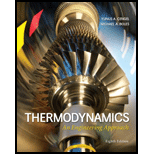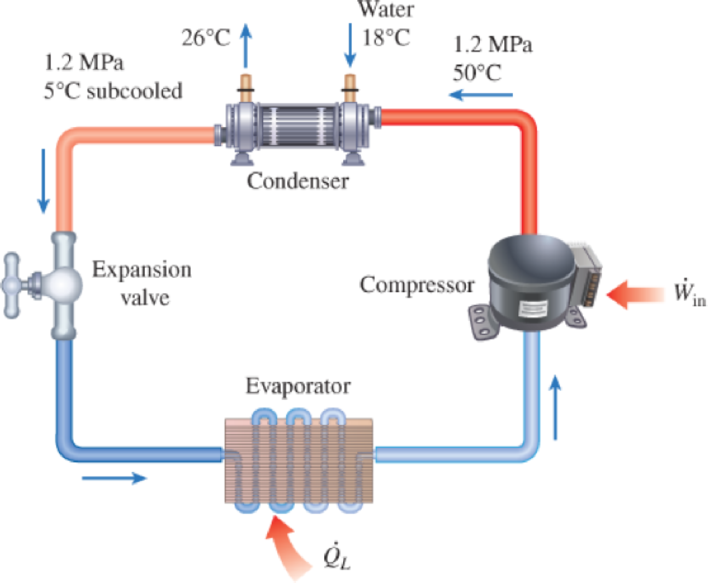
A commercial refrigerator with refrigerant-134a as the working fluid is used to keep the refrigerated space at −35°C by rejecting waste heat to cooling water that enters the condenser at 18°C at a rate of 0.25 kg/s and leaves at 26°C. The refrigerant enters the condenser at 1.2 MPa and 50°C and leaves at the same pressure subcooled by 5°C. If the compressor consumes 3.3 kW of power, determine (a) the mass flow rate of the refrigerant, (b) the refrigeration load, (c) the COP, and (d) the minimum power input to the compressor for the same refrigeration load.
FIGURE P6–107

(a)
The mass flow rate of the refrigerant.
Answer to Problem 101P
The mass flow rate of the refrigerant is
Explanation of Solution
Determine the rate of heat transferred to the water.
Here, the mass flow rate of the water is
Determine the mass flow rate of a refrigerant.
Conclusion:
From the Table A-13, “Superheated refrigerant R-134a” obtain the value of enthalpy of the refrigerant at the inlet of the condenser at the 1.2 MPa of pressure and
From the Table A-13, “Superheated refrigerant R-134a” obtain the value of temperature of the refrigerant at the inlet of the condenser at the 1.2 MPa of pressure as,
Calculate the exit temperature of the refrigerant in the condenser.
Here, the temperature leave from the condenser is
Substitute
Refer to Table A-11, “Saturated refrigerant R-134a”, obtain the below exit enthalpy of the condenser at compressed liquid state on the basis of exit temperature of
Write the formula of interpolation method of two variables.
Here, the variables denote by x and y are temperature and enthalpy of vaporization.
Show the temperature at
| S. No |
Temperature, |
enthalpy of vaporization |
| 1 | ||
| 2 | ||
| 3 |
Calculate exit enthalpy of the condenser at compressed liquid state on the basis of exit temperature of
Substitute
From above calculation the exit enthalpy of the condenser at compressed liquid state on the basis of exit temperature of
Repeat the above Equation (IV) to obtain the value of enthalpy of saturated liquid that entering the inlet of the condenser at the
Repeat the above Equation (IV) to obtain the value of enthalpy of saturated liquid which is leaving the condenser at the
Substitute
Substitute
Thus, the mass flow rate of the refrigerant is
(b)
The refrigeration load of the refrigerator.
Answer to Problem 101P
The refrigeration load of the refrigerator is
Explanation of Solution
Determine the refrigeration load of the refrigerator.
Here, the power input consumed by compressor is
Conclusion:
Substitute
Thus, the refrigeration load of the refrigerator is
(c)
The COP of a reversible refrigerator operating between the same temperature limits.
Answer to Problem 101P
The COP of a reversible refrigerator operating between the same temperature limits is
Explanation of Solution
Determine the coefficient of performance of the refrigerator.
Conclusion:
Substitute
Thus, the COP of a reversible refrigerator operating between the same temperature limits is
(d)
The minimum power input to the compressor.
Answer to Problem 101P
The minimum power input to the compressor is
Explanation of Solution
Determine the maximum coefficient of performance of the reversible refrigerator operating between the same temperature limits.
Here, the temperature of higher temperature body is
Determine the minimum power input to the condenser for the same refrigerator load.
Conclusion:
Substitute
Substitute
Thus, the minimum power input to the compressor is
Want to see more full solutions like this?
Chapter 6 Solutions
Thermodynamics: An Engineering Approach
- The flow rate is 12.275 Liters/s and the diameter is 6.266 cm.arrow_forwardAn experimental setup is being built to study the flow in a large water main (i.e., a large pipe). The water main is expected to convey a discharge (Qp). The experimental tube will be built at a length scale of 1/20 of the actual water main. After building the experimental setup, the pressure drop per unit length in the model tube (APm/Lm) is measured. Problem (20): Given the value of APm/Lm [kPa/m], and assuming pressure coefficient similitude, calculate the drop in the pressure per unit length of the water main (APP/Lp) in [Pa/m]. Givens: AP M/L m = 590.637 kPa/m meen Answers: ( 1 ) 59.369 Pa/m ( 2 ) 73.83 Pa/m (3) 95.443 Pa/m ( 4 ) 44.444 Pa/m *******arrow_forwardFind the reaction force in y if Ain = 0.169 m^2, Aout = 0.143 m^2, p_in = 0.552 atm, Q = 0.367 m^3/s, α = 31.72 degrees. The pipe is flat on the ground so do not factor in weight of the pipe and fluid.arrow_forward
- Find the reaction force in x if Ain = 0.301 m^2, Aout = 0.177 m^2, p_in = 1.338 atm, Q = 0.669 m^3/s, and α = 37.183 degreesarrow_forwardProblem 5: Three-Force Equilibrium A structural connection at point O is in equilibrium under the action of three forces. • • . Member A applies a force of 9 kN vertically upward along the y-axis. Member B applies an unknown force F at the angle shown. Member C applies an unknown force T along its length at an angle shown. Determine the magnitudes of forces F and T required for equilibrium, assuming 0 = 90° y 9 kN Aarrow_forwardProblem 19: Determine the force in members HG, HE, and DE of the truss, and state if the members are in tension or compression. 4 ft K J I H G B C D E F -3 ft -3 ft 3 ft 3 ft 3 ft- 1500 lb 1500 lb 1500 lb 1500 lb 1500 lbarrow_forward
- Problem 14: Determine the reactions at the pin A, and the tension in cord. Neglect the thickness of the beam. F1=26kN F2 13 12 80° -2m 3marrow_forwardProblem 22: Determine the force in members GF, FC, and CD of the bridge truss and state if the members are in tension or compression. F 15 ft B D -40 ft 40 ft -40 ft 40 ft- 5 k 10 k 15 k 30 ft Earrow_forwardProblem 20: Determine the force in members BC, HC, and HG. After the truss is sectioned use a single equation of equilibrium for the calculation of each force. State if the members are in tension or compression. 5 kN 4 kN 4 kN 3 kN 2 kN B D E F 3 m -5 m- -5 m- 5 m 5 m-arrow_forward
- An experimental setup is being built to study the flow in a large water main (i.e., a large pipe). The water main is expected to convey a discharge (Qp). The experimental tube will be built at a length scale of 1/20 of the actual water main. After building the experimental setup, the pressure drop per unit length in the model tube (APm/Lm) is measured. Problem (19): Given the value of Qp [m³/s], and assuming Reynolds number similitude between the water main and experimental tube, calculate the flow rate in the model tube (Qm) in [lit/s]. = 30.015 m^3/sarrow_forwardProblem 11: The lamp has a weight of 15 lb and is supported by the six cords connected together as shown. Determine the tension in each cord and the angle 0 for equilibrium. Cord BC is horizontal. E 30° B 60° Aarrow_forwardProblem 10: If the bucket weighs 50 lb, determine the tension developed in each of the wires. B $30° 5 E D 130°arrow_forward
 Elements Of ElectromagneticsMechanical EngineeringISBN:9780190698614Author:Sadiku, Matthew N. O.Publisher:Oxford University Press
Elements Of ElectromagneticsMechanical EngineeringISBN:9780190698614Author:Sadiku, Matthew N. O.Publisher:Oxford University Press Mechanics of Materials (10th Edition)Mechanical EngineeringISBN:9780134319650Author:Russell C. HibbelerPublisher:PEARSON
Mechanics of Materials (10th Edition)Mechanical EngineeringISBN:9780134319650Author:Russell C. HibbelerPublisher:PEARSON Thermodynamics: An Engineering ApproachMechanical EngineeringISBN:9781259822674Author:Yunus A. Cengel Dr., Michael A. BolesPublisher:McGraw-Hill Education
Thermodynamics: An Engineering ApproachMechanical EngineeringISBN:9781259822674Author:Yunus A. Cengel Dr., Michael A. BolesPublisher:McGraw-Hill Education Control Systems EngineeringMechanical EngineeringISBN:9781118170519Author:Norman S. NisePublisher:WILEY
Control Systems EngineeringMechanical EngineeringISBN:9781118170519Author:Norman S. NisePublisher:WILEY Mechanics of Materials (MindTap Course List)Mechanical EngineeringISBN:9781337093347Author:Barry J. Goodno, James M. GerePublisher:Cengage Learning
Mechanics of Materials (MindTap Course List)Mechanical EngineeringISBN:9781337093347Author:Barry J. Goodno, James M. GerePublisher:Cengage Learning Engineering Mechanics: StaticsMechanical EngineeringISBN:9781118807330Author:James L. Meriam, L. G. Kraige, J. N. BoltonPublisher:WILEY
Engineering Mechanics: StaticsMechanical EngineeringISBN:9781118807330Author:James L. Meriam, L. G. Kraige, J. N. BoltonPublisher:WILEY





